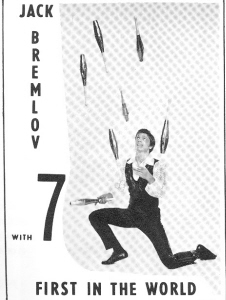
Back view of mechanism with cover removed. |

Jack Bremlov |
Page 22 March 1982
|
This
disc rolls against a plane as the chains carry the rods through their
cycle. This rotation carries to the club which is frictionally
connected to the rod. The clubs normally turn with the rods due to
this friction. However, when the strike the clown's hands, slippage
occurs and they stop turning, remaining horizontal for a short
period, as with real juggling. Without this slippage, the clubs would
turn 31/2 revolutions from one hand to the other.
The
"glitch" holds the clubs back for a halfrevolution, giving
the triple spins of Virgoaga. The clown's hands are driven by a
crankshaft in synchronization with the clubs, and his head is also
All
of the clown and prop motions are driven by one synchronous motor at a
rate of 1.3 throws
Scaled-down
models in general appear too busy unless the time scale is slowed down
as well. The music is produced by a Casio "VL-Tone" adjusted
to the same timing as the clowns.
The
ball and club jugglers are the most interesting of the three. While
the ball juggler perhaps gives the most accurate representation of
reality, the clubs involve the mot complexity of object movements.
The
greatest numbers jugglers of all time cannot sustain their record
patterns for more than a few minutes, but my little clowns juggle all
night and never drop a prop! |

Back view of mechanism with cover removed. |

Jack Bremlov |